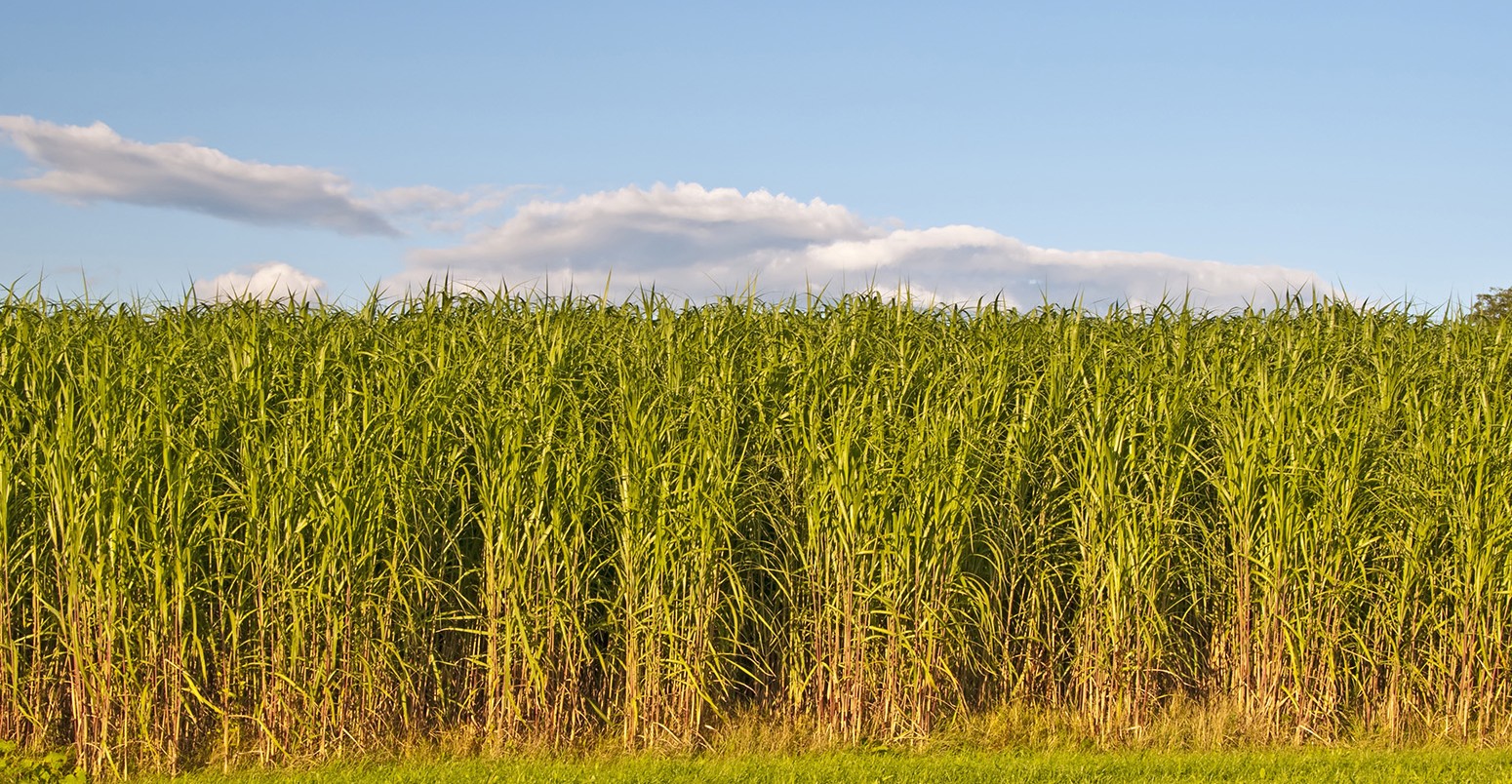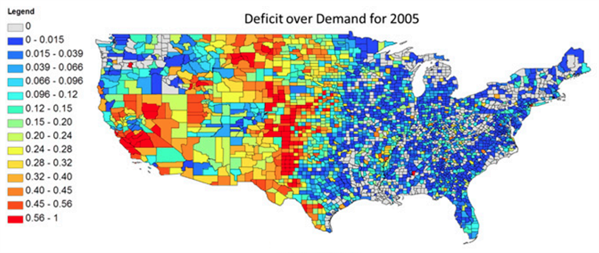
Emissions cuts using biofuels could worsen water stress in US, study suggests
Robert McSweeney
08.03.15Robert McSweeney
03.08.2015 | 8:00pmUsing biofuels as a way to cut greenhouse gas emissions could put US water resources under increasing pressure, a new study suggests. Researchers find that a heavy reliance on bioenergy could mean a 42% increase in water consumption across the US by 2100.
The results show that policies to mitigate climate change need to be carefully planned to avoid knock-on effects on natural resources, the researchers say.
Water deficits
The new study, published in Proceedings of the National Academy of Sciences, analysed “water deficits” across the US. Deficits occur when demand for water outstrips the supplies available in local or neighbouring rivers and reservoirs.
The map below shows that much of the US is already in deficit for water. The orange and red areas in the main map below show the counties in US that are already worst affected by water stress.
Average total annual water deficit as a fraction of demand in 2005. Source: Hejazi et al (2015)
Using computer models, the researchers simulated how these deficits might change with different approaches for tackling global carbon emissions to limit the impacts of climate change.
The results show that measures to cut carbon emissions could mean water deficits are more severe by the end of the century.
Bioenergy
The study compared the impact on water stress of two scenarios, or representative concentration pathways, for how we deal with rising carbon emissions. RCP4.5 describes a world where the concentration of carbon dioxide in the atmosphere is stabilised at around 650 parts per million (ppm) by 2100.
In contrast, RCP8.5 is a future where emissions are not curbed and carbon dioxide concentrations rise to around 1,370ppm by 2100. The paper refers to RCP8.5 as a “business-as-usual” scenario.
In RCP4.5, bioenergy forms an important alternative to fossil fuels, alongside renewables and nuclear. Biofuels are also combined with carbon capture and storage to produce electricity with negative emissions.
The researchers considered just one type of biofuel, which is switchgrass. This a perennial grass that grows across much of the North American prairies. It can be used to make ethanol or be burnt directly for heating or electricity generation.
But while these biofuels helps cut emissions, they need a lot of water to grow. The simulations show that water consumption across the US could increase 42% by 2100 under RCP4.5. Much of this increase could be for irrigating biofuel crops, the researchers say.
You can see the simulated changes in the maps below. The greater spread of yellow and orange areas show the rise in water deficits is more pronounced under RCP4.5 (top row) than RCP8.5 (bottom row). As the paper puts it:
“Water demands generally increase over time in both scenarios because of population growth and demands for food and energyâ?¦but, there is a large increase in water demands for irrigation of bioenergy crops in RCP4.5”.
The difference in average annual water deficit 2005 and the 2020s, 2050s, and 2080s, under RCP4.5 (top row) and RCP8.5 (bottom row). Source: Hejazi et al (2015)
The study finds that both water supply and demand would be higher if emissions are curbed compared to business-as-usual. Lead author Dr Mohamad Hejazi, a scientist at the University of Maryland, explains to Carbon Brief why this happens:
“Reduced warming increases the water supply because less of the supply evaporates. Howeverâ?¦ the increased water supply due to less evaporation is used up and surpassed by the increased water demand [from irrigation], leading to a greater water deficit.”
This highlights that mitigation has the potential to help reduce both global emissions reduction and water stress, Hejazi says:
“The climate benefit of mitigation can be realised for temperature and water stress if designed carefully toward less water-intensive mitigation options.”
If emissions are reduced with minimal increase in bioenergy, the increase in water consumption drops to 12%, the paper finds.
Smart mitigation
These results contrast with similar studies that found cutting carbon emissions is more beneficial for water stress than business-as-usual scenarios, the paper notes.
Each study has different assumptions, models and scenarios that go into it, the paper says. But the new study considers water stress at much finer geographical scales, says Hejazi, and water stress is often a local issue which could be missed by the other studies.
Dr Naota Hanasaki, a senior researcher at the National Institute for Environmental Studies in Japan, was the lead author of similar research on a global scale. He tells Carbon Brief that his study didn’t consider irrigation for biofuels because the detailed scenarios for crop production weren’t available at the time. These new results will hopefully provoke further analyses by other groups to explore the uncertainties in future crop production, Hanasaki says.
The results of the new study highlight that there are smart ways to reduce emissions and “stupid” ways, says Dr Peter Gleick, president and co-founder of the Pacific Institute, an organisation established to help find solutions to global water challenges. He tells Carbon Brief:
“The stupid ones are those that reduce emissions of greenhouse gases, but make other problems worse. In this case, attempting to mitigate greenhouse gas emissions by replacing fossil fuels with biofuels falls into [this] category – something people have argued for a long time – precisely because of the massive pressure biofuels place on water resources.”
The next challenge is to explore how mitigation strategies can be tailored to avoid adverse impacts on water availability, says Hejazi.
Main image: Switchgrass, a biomass crop for ethanol and butanol.
Hejazi et al. (2015) 21st century United States emissions mitigation could increase water stress more than the climate change it is mitigating, Proceedings of the National Academy of Sciences, doi:10.1073/pnas.1421675112.
-
Using biofuels as a way to cut greenhouse gas emissions could put US water resources under increasing pressure, a new study suggests
-
Researchers have found that a heavy reliance on bioenergy could mean a 42% increase in water consumption across the US by 2100



